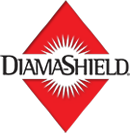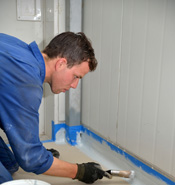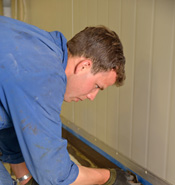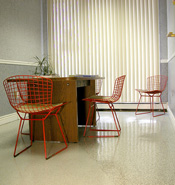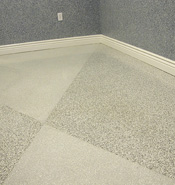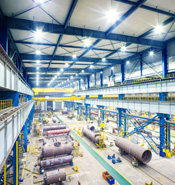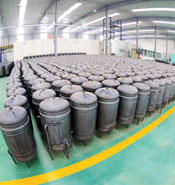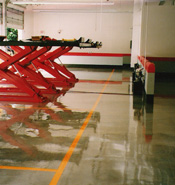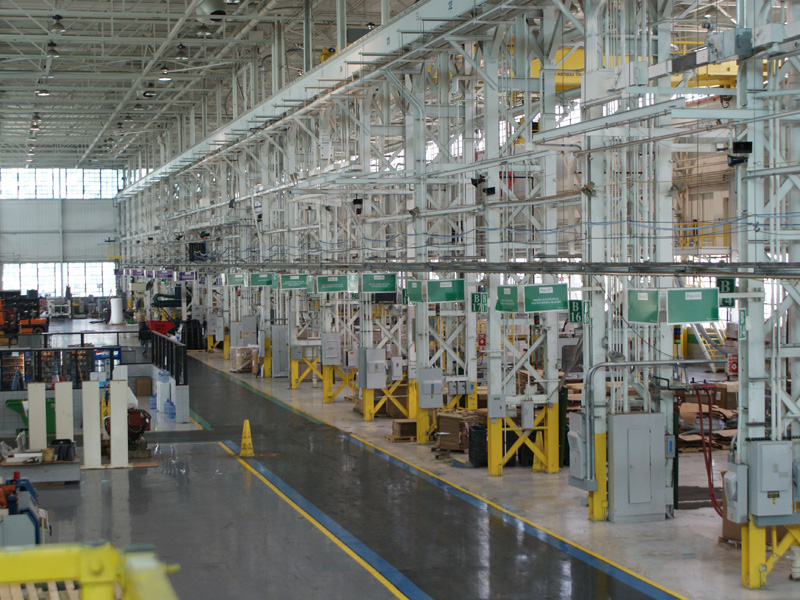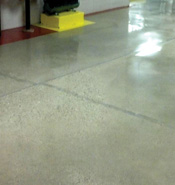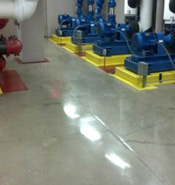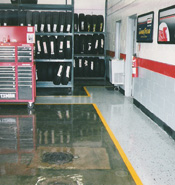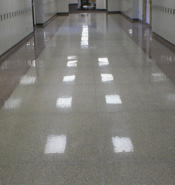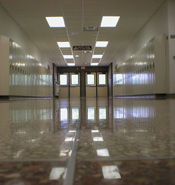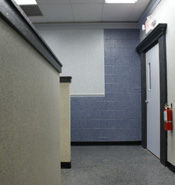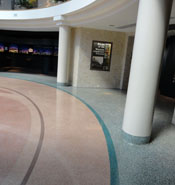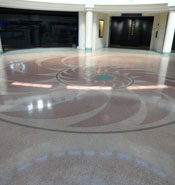Diama-Shield prides itself on being a single source contractor capable of handling a wide variety of commercial and industrial flooring needs. In addition to concrete polishing, polished concrete maintenance and epoxy floor coating services, Diama-Shield also offers the following products and services:
- Ceramic Tile Removal
- VCT Removal
- Thermoplastic Roofing
- Thermoset Roofing
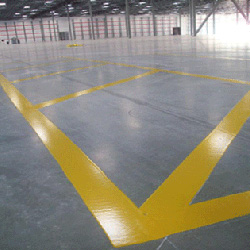 Safety Striping
Safety Striping
Safety striping provides occupational health and safety benefits as well as increased productivity and organization. Diama-Shield is able to install safety striping in compliance with OSHA requirements as well as applicable and building codes. Other areas in plants, warehouses and industrial buildings benefit from clearly demarcated staging areas, equipment pads and material handling vehicle paths. Safety and productivity are improved by having safety striping professionally installed.
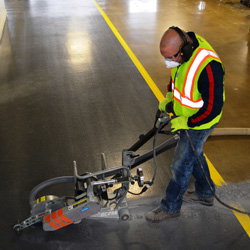 Trip Hazard Repair
Trip Hazard Repair
Trip hazards and uneven slabs represent avoidable injuries and unnecessary losses in productivity. Diama-Shield can efficiently grind and level trip hazards to protect the public, provide a safer work environment, increase productivity and reduce potential liability claims.
The Americans with Disabilities Act (ADA) defines a trip hazard as any vertical change of ¼” or more at a joint or crack in a walkway surface. Federal law requires removal of all trip hazards from pedestrian walkways. Failure to comply with the ADA can result in costly fines and complex legal claims.
Diama-Shield's process leaves sidewalks and other means of ingress and egress safe, accessible and attractive.
The Advantages of Trip Hazard Removal
- Cost Savings: Concrete grinding and leveling the most cost effective and least disruptive method of eliminating trip hazards.
- Regulatory Compliance: Comply with the Americans with Disabilities Act, OSHA regulations and local building codes.
- Avoid Liability Issues: Removal of Trip Hazards will greatly reduce the exposure to trip and fall lawsuits and other liability claims.
- Lower Insurance Costs: Realize lower insurance rates by implementing a trip hazard removal program.
- Less Disruptive than Replacement: Trip hazard repair and remediation by grinding and leveling the concrete lip is the most effective, efficient trip hazed removal method. It is faster, more convenient and less costly than slab replacement
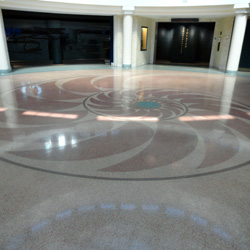 Terrazzo Restoration
Terrazzo Restoration
Diama-Shield offers a terrazzo restoration system which incorporates industrial polishing equipment, diamond abrasives and specially formulated densifiers to restore dull, distressed terrazzo flooring. Diama-Shield’s high-gloss terrazzo floor finish provides an extremely durable surface which resists scuff marks, scratches and abuse and eliminates the need for stripping and waxing. Diama-Shield's terrazzo restoration process is ideal for:
- Schools
- Museums
- Airports
- Hospitals
- Stadiums and Arenas
- Government Buildings
- Shopping Malls
- Office Buildings
- Convention Centers
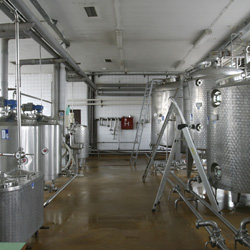 Cemetitious Overlays
Cemetitious Overlays
Diama-Shield has the ability to repair and resurface damaged concrete by installing cemetitious overlays. Repairing damaged slabs is far more cost effective and less disruptive than ripping out and replacing a damaged but structurally sound slab.
Overlays also provide the ability to add new colors, finishes, performance attributes, textures and patterns to make an old floor look and function better than the original surface.
Overlay Options Include:
Self-Leveling Concrete Overlays
Self-leveling concrete overlays are recommended where a smooth or polished finish is desired. This type of overlayments is designed to smooth and level out a damaged, pitted or rough concrete surfaces. An average self-leveling overlays is 1/4 inch thick but can be installed at thickness of up to 2 inches in a single application. Self-leveling systems are flowed over an existing substrate to provide a smooth, level, functional surface.
Self-leveling overlay systems for con offer numerous advantages. They can correct uneven floors, repair damaged concrete, and provide a smooth and durable new surface for decorative treatments. These flowable polymer-modified toppings have the ability to self-level without troweling, making them a quick solution for smoothing and leveling worn or uneven concrete.
In many cases, self-leveling toppings serve a purely utilitarian purpose, such as correcting uneven or damaged floors or serving as an underlayment for tile, carpet, or other floor coverings. Self-leveling overlays can also be used for decorative purposes. Integral colors can be added or the cured surface may be enhanced by using concrete stains and dyes. The overlay can be left seamless (except at control joints) or used as a canvas for saw cut or engraved designs. Decorative inlays, such as strips of wood or metal, can be incorporated into the design element to give a custom, high end appearance.
Microtoppings and Thin Resurfacing
Microtoppings are ultra-thin cement, aggregate and polymer modified resurfacing systems. Typical microtoppings are less than 1/8th of an inch thick with some being thin enough to allow for spray application. Thin build microtopping systems can be sprayed through a textured hopper. Thicker microtopping overlays are typically troweled or squeegeed with a variety specialty tools
Cement-based microtoppings and skim coats can be used both indoors and out to provide a clean canvas for decorative treatments, such as stains, dyes and stenciled patterns. Some systems come pretinted in a wide range of colors, while others can be custom tinted by mixing in the desired amount of liquid coloring agent. Interesting color variations can be achieved by applying layers of different hues.
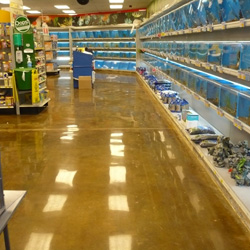 Concrete Stains and Dyes
Concrete Stains and Dyes
Concrete stains and dyes are increasingly popular ways of adding color and decorative elements to polished concrete floors. A limitless array of colors, designs and effects are now possible with advances in stain and dye technologies. Colored concrete is an affordable way to dramatically improve your floor’s appearance. Concrete stains and dyes can be combined with artistic saw cutting or sandblasting to create individualized distinctive looks. Let Diama-Shield help you transform your drab concrete floor into a stunning architectural showpiece.
Concrete Stains
Concrete stains penetrate the surface and react with the hydrated lime in concrete to produce permanently colored concrete. Once stains react with concrete, they color change becomes a permanent part of the substrate. Concrete stains will not chip, peel or wear away. Because concrete stains are UV stable, they can be used indoors or outdoors and will not fade.
Stains produce translucent, marbled, variegated finishes. Stains are particularly well suited when earth tones like tans, terra cottas, browns, teals, blues and greens are desired. Because they are reactive and translucent, stains allow unique properties of each individual floor to shine through creating distinctive, natural looks which can resemble marble, stone, wood, terra cotta or plaster.
Concrete Dyes
Unlike stains, which react chemically with calcium hydroxide in the concrete, dyes are nonreactive and impart color by penetrating concrete or other porous cemetitious surfaces. Concrete dyes consist of very fine coloring agents which penetrate concrete surfaces with the aid of a water or solvent based carrier. The dye’s small molecular size allows it to fill naturally occurring voids producing vivid colors by sheer volume of dye particles being locked into the slab.
Dyes are commonly used where bright, bold colors are desired. In addition to being available in a wide variety of vivid colors, dyes can also provide more predictable, monotone appearances because they do not rely on a chemical reaction to create a final color or appearance. The dye may be mixed with other colors on site. Dyes are usually applied with pump sprayers, but may be applied with airless sprayer, airbrush, sponge or brush, depending on the desired effect and the size of the area to be colored. With dyes, concrete slabs become canvases upon which artists can create stunning patterns and designs which are limited only by ones imagination.
Stain and Dye Combinations
Dyes are often used in conjunction with acid stains to produce a variegated look to complement an already stained floor. For example, a customer may want the graphic variegation of a reactive stain, but in a color not available. A dye can be applied over the stain to give a brighter color while allowing the pattern created by the reactive stain to show through. Dyes might also be applied by hand over parts of a stained surface to "paint" a picture or add highlights or accents. Because the chemical reactions upon which stains rely can be unpredictable and may produce uneven results, dyes can be used to touch-up and even out stained floors to give a natural but more consistent look than would be achievable through only using one concrete coloring method.
Sometimes a stained overlay is the best solution for concrete surfaces that show damage or have been abused during construction. Commercially available overlay materials can be integrally colored, textured, and stained to provide a new range of decorative possibilities. The overlays have high flexural strength and wear resistance. As with everything involving stains, however, it's wise to create a sample to ensure compatibility of the overlay cement with the stain and to get owner approval for the result.
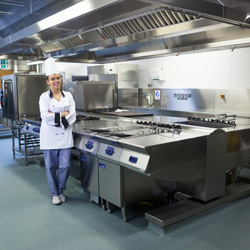 Quartz Floors
Quartz Floors
Quartz Flooring is a seamless flooring system consisting of a 100% solids epoxy base coat filled with a custom blend of quartz, marble or ceramic aggregate. Quartz floors are durable, chemical resistant, anti-slip and easy to clean. An infinite variety of custom color blends make quartz floors popular when aesthetic and design concerns are important. A wide selection of gloss and satin finish coats are also available for varying appearance and exposure requirements. Quartz flooring is UV stable making it suitable for both indoor and outdoor applications.
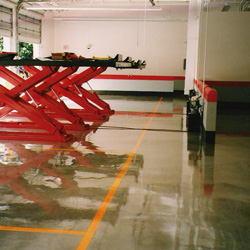 Floor Sealing
Floor Sealing
Concrete sealers are used to protect concrete from weather and chemical damage, control dusting and improve its appearance. Concrete sealers will also prolong a concrete surface’s longevity. Diama-Shield is experienced in applying a wide variety of concrete sealers including:
Penetrating Sealers
Penetrating sealers such as silanes, siloxanes, and silicates, penetrate into the concrete to form a chemical barrier that shields against moisture penetration and deicing chemicals. These sealers enter naturally occurring capillaries and react with compounds in the slab to protect against moisture penetration and deicing chemicals. Penetrating sealers improve durability by protecting against the elements while helping keep moisture from entering the concrete, penetrating sealers have the advantage of being breathable, allowing moisture vapor to escape and helping to reduce and reducing freeze-thaw damage. Penetrating sealers have good chemical resistance and can be used on both indoor and outdoor surfaces. They provide invisible protection and do not change the concrete’s appearance. A penetrating sealer is recommended where the objective is to:
- Protect exterior concrete surfaces subject to corrosion and freeze-thaw damage;
- Obtain a natural, matte finish;
- Avoid a glossy film which can result in a slippery surface;
- Provide invisible protection without changing the surface appearance or leaving a sheen.
Film-Forming
Film forming sealers form a protective film on the concrete surface. They are most often used on decorative concrete work. This final layer of protection not only prolongs a decorative floors life, but can also enhance and preserve its appearance.
The three most popular types of film forming sealers are:
- Acrylics - Acrylic sealers are available in both water based and solvent based versions. Acrylics are UV resistant, non-yellowing and provide good protection against water and deicing chemical absorption. These sealers are economical and can be used in a wide variety of applications. Because acrylics are typically applied somewhat thinner than polyurethanes or epoxies, they tend to wear faster and requiring resealing more often. Acrylic sealers provide excellent performance at low cost. Advantages of Acrylic sealers Include:
- Can be used on both interior and exterior concrete;
- Enhance the beauty of colored, stained, stamped or exposed aggregate concrete;
- Fast drying will usually dry to the touch within an hour;
- Come in different sheen levels, solvent based usually enhance color better than water based
- Polyurethanes - Polyurethane sealers are also available in water and solvent based formulas. Polyurethanes are thick mill systems (typically applied twice as thick as acrylic sealers) and provide superior protection against chemicals and abrasives. Advantages of Polyurethane sealers include:
- Can be used on both interior and exterior concrete
- Transparent, non-yellowing, highly durable finish.
- Recommended for in high-traffic areas
- Provide good resistance to scuffs and staining
- Enhance the beauty of colored, stamped or exposed-aggregate concrete
- Epoxies - Epoxies form high-build protective coatings that provide hard, long lasting, abrasion resistant finish. Epoxies have excellent adhesion to concrete and cement overlays. These popular sealers come in clear and pigmented varieties. Epoxies are generally used on inside applications as they might yellow if exposed to UV rays. Advantages of Epoxy sealers include:
- Superior abrasion resistance
- Attractive high-gloss sheen
- Suitable for high traffic areas
- Excellent adhesion to cemetitious overlays
- Provide a moisture barrier
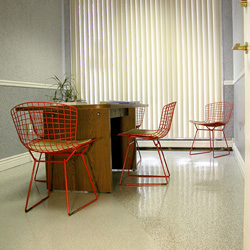 Epoxy Wall Coatings
Epoxy Wall Coatings
Diama-Shield is a certified installer of GranX epoxy wall coating systems. GranX is a commercial grade seamless epoxy wall coating system that is extremely durable, sanitary, resistant to harsh chemicals and cleaners and easy to clean along with being a solution to Graffiti problems.
Seamless epoxy wall coatings are very popular in high traffic public areas requiring durability and easy graffiti removal. GranX surfaces can be cleaned with pressure water making it ideal for public restrooms, showers, service and residential garages, and basements.
A wide variety of colors and textures are available allowing owners to economically transform most building materials into attractive, long lasting durable surfaces. GranX adheres to FRP, ceramic tile, cement block, drywall, wood, wall paper, metal and more.
